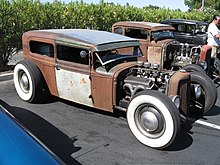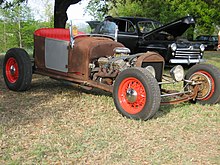Rat rod: Difference between revisions
m Fix links to disambiguation page Roadster |
|||
| Line 59: | Line 59: | ||
* [http://ratrodstuff.com/How-to-Build-a-rat-rod How to build a rat rod] |
* [http://ratrodstuff.com/How-to-Build-a-rat-rod How to build a rat rod] |
||
* [http://chattanoogaratrodassociation.com Chattanooga Rat Rod Association] |
* [http://chattanoogaratrodassociation.com Chattanooga Rat Rod Association] |
||
* [http://www.rat-rods.info/Rat-rods-for-sale Rat rods for sale] |
|||
==Notes== |
==Notes== |
||
Revision as of 10:59, 6 April 2012
This article needs additional citations for verification. (November 2007) |

A rat rod is a style of hot rod or custom car that, in most cases, imitates (or exaggerates) the early hot rods of the 40s, 50s & early 60s. It is not to be confused with the somewhat closely related "traditional" hot rod, which is an accurate re-creation or period-correct restoration of a hot rod from the same era.
Most rat rods appear "unfinished" (whether they actually are or not), with just the bare essentials to be driven.
The rat rod is the visualization of the idea of function over form. Rat rods are meant to be driven, not shown off. Sometimes the customization will include using spare parts, or parts from another car altogether.
Definition
Originally a counter-reaction to the high priced "customs" and typical hot rods, many of which seldom were driven, the rat rod's beginning was a throwback to the hot rods of the earlier days of hot-rodding, built to the best of the owner's abilities and meant to be driven. Rat rods are meant to loosely imitate in form and function the "traditional" hot rods of the era. Biker, greaser, rockabilly, psychobilly, and punk cultures are often credited as influences that shaped rat rodding.
The typical rat rod is a late 1920s through late 1950s coupe or roadster. Early (pre-World War II) vehicles often have their fenders, hoods, running boards, and bumpers removed. The bodies are frequently channeled over the frame, and sectioned, or the roofs chopped for a lower profile. Later post-war vehicles are rarely constructed without fenders and are often customized in the fashion of Kustoms, leadsleds, and lowriders. Maltese crosses, skulls, and other accessories are often added. Chopped tops, shaved trim, grills, tail lights, and other miscellaneous body parts are swapped between makes and models. Most, if not all, of the work and engineering is done by the owner of the vehicle.
Recently, the term "rat rod" (or rat car, as modern cars are not actually hot rods like the name suggests) has been used to describe almost any vehicle that appears unfinished or is built simply to be driven.
General
Chassis
Frames from older cars or light trucks are sometimes preferred for the chassis, because they provide a sturdy base for subsequent alterations. Older cars in poor condition are often advertised as candidates for rat rod conversions. In some cases the owner will design and build the frame themselves. In other cases, a "Rat Rodder" may use a small pick-up chassis such as an Chevy S-10 and place an older car body on it, to get the look of the classic, with the reliability of the modern vehicle.
Paint and finish

Almost by definition, rat rods appear unfinished, with primer-only paint jobs at most. Satin or matte black and other flat colors are also common. Other finishes may include “natural patina” (the original paint with rust, blemishes, and sometimes bullet holes left intact), a patchwork of original paint and primer, or bare metal with no finish at all in rusty or oiled varieties, honoring the anti-restoration slogan that "it's only original once". Many rat rods also have free hand pinstriping done by the owners with a pinstriping brush. Contrary to tastes of many car builders, rust is often acceptable and appreciated by a rat rodder.
Interior
Interiors of rat rods vary from fully finished to a spartan, bare bones form. Mexican blankets and bomber seats form the basis of many rat rod interiors. Most are designed to be functional without many comforts although this will vary with the owner’s taste.
Drive train
Though a variety of engines may be used, the most common to be found in a rat rod are flathead V8's, early Chrysler Hemi engines, or more modern small block V8's from any manufacturer, especially Chevrolet. It is not uncommon to see straight-8s straight-6s, straight-4 and V6s. These engines may exhibit varying displacements and modifications. Diesel engines are occasionally seen as well. These engines are rarely fitted with emission controls, as they were not manufactured originally with them or are not required under special licence.
Most rat rods are rear wheel drive, with an open driveline. The rear-ends are typically passenger vehicle pieces, as are the transmissions. The Ford Banjo rear-end is popular, as is the "Quickchange" type as used in many early hot rods.
Suspension
A beam axle is commonly accepted as the only type of front suspension that will look right when exposed without fenders on a vehicle with open front suspension. Independent front suspension is discouraged, and most rat rods use a 1928-1948 Ford I-beam axle with a transverse leaf spring. Although any solid axle is acceptable, the Ford axle is preferred due to the availability of spare parts.
Springs vary from transverse, parallel and coil setups in the front and rear. Parallel is not seen as frequently as the more common single-spring transverse setup, though both are used commonly. Coil springs are often deemed unsightly without fenders, but are still occasionally seen. Rat rods also will often have airbag suspension, which allows the driver to raise and lower the car, a useful feature giving the extremely low ground clearance of many rat rods..
In many cases the front suspension is mounted well forward of the radiator. This may be derived from a similar practice in early drag racing cars.
Origins
The December 1972 issue of Rod & Custom Magazine was dedicated to the "beater", a low-budget alternative to the over-polished, slickly-painted, customized early car. The beater could easily be considered a progenitor of the rat rod with its cheap upholstery, primer instead of paint, and lack of chrome or polished metals. However, owners of these beaters often had a high-dollar machine sitting in their garage.
As with many cultural terms, there are disputes over the origin of the term "rat rod". Some say it first appeared in an article written in Hot Rod Magazine by Gray Baskerville about cars that still sported a coat of primer. Some claim that the first rat rod was owned by artist Robert Williams who had a '32 Ford Roadster that was painted in primer. Hot Rod magazine has since verified this.[1] Although the term likely started out as derogatory or pejorative (and is still used in this way by many), members of the subcultures that build and enjoy these cars have adopted the term in a positive light.
See also
References
This section is empty. You can help by adding to it. (July 2010) |
External links
- National Rat Rod Association
- Rat Rod Magazine
- How to build a rat rod
- Chattanooga Rat Rod Association
- Rat rods for sale
Notes
- ^ sketchv. "Robt. Williams Lecture Oakland Museum of CA 2008 Pt.03". Youtube.com. Retrieved 2011-11-20.
